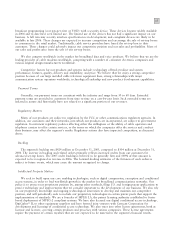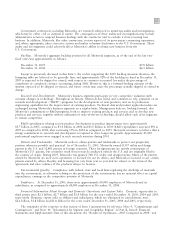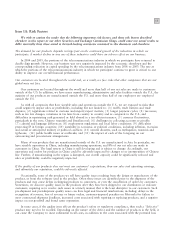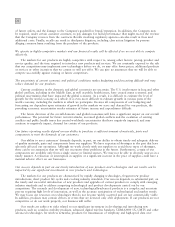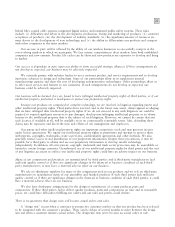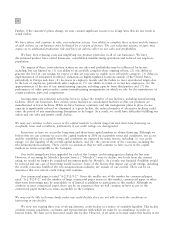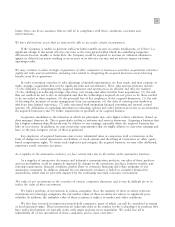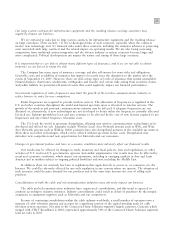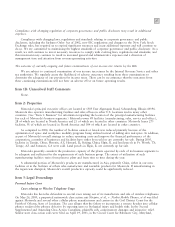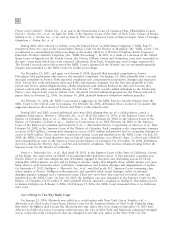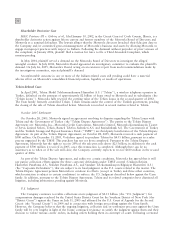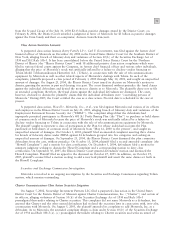Motorola 2005 Annual Report Download - page 30
Download and view the complete annual report
Please find page 30 of the 2005 Motorola annual report below. You can navigate through the pages in the report by either clicking on the pages listed below, or by using the keyword search tool below to find specific information within the annual report.
23
future, there can be no assurance that we will be in compliance with these conditions, covenants and
representations.
We have deferred tax assets that we may not be able to use under certain circumstances.
If the Company is unable to generate sufficient future taxable income in certain jurisdictions, or if there is a
significant change in the actual effective tax rates or the time period within which the underlying temporary
differences become taxable or deductible, the Company could be required to increase its valuation allowances
against its deferred tax assets resulting in an increase in its effective tax rate and an adverse impact on future
operating results.
We may continue to make strategic acquisitions of other companies or businesses and these acquisitions introduce
significant risks and uncertainties, including risks related to integrating the acquired businesses and achieving
benefits from the acquisitions.
In order to position ourselves to take advantage of growth opportunities, we have made, and may continue to
make, strategic acquisitions that involve significant risks and uncertainties. These risks and uncertainties include:
(1) the difficulty in integrating newly-acquired businesses and operations in an efficient and effective manner;
(2) the challenges in achieving strategic objectives, cost savings and other benefits from acquisitions; (3) the risk
that our markets do not evolve as anticipated and that the technologies acquired do not prove to be those needed
to be successful in those markets; (4) the potential loss of key employees of the acquired businesses; (5) the risk
of diverting the attention of senior management from our operations; (6) the risks of entering new markets in
which we have limited experience; (7) risks associated with integrating financial reporting and internal control
systems; (8) difficulties in expanding information technology systems and other business processes to accommodate
the acquired businesses; and (9) future impairments of goodwill of an acquired business.
Acquisition candidates in the industries in which we participate may carry higher relative valuations (based on
their earnings) than we do. This is particularly evident in software and services businesses. Acquiring a business that
has a higher valuation than Motorola may be dilutive to our earnings, especially when the acquired business has
little or no revenue. In addition, we may not pursue opportunities that are highly dilutive to near-term earnings and
have, in the past, foregone certain of these acquisitions.
Key employees of acquired businesses may receive substantial value in connection with a transaction in the
form of change-in-control agreements, acceleration of stock options and the lifting of restrictions on other equity-
based compensation rights. To retain such employees and integrate the acquired business, we may offer additional,
sometimes costly, retention incentives.
As a supplier to the automotive industry, we face certain risks due to the nature of the automotive business.
As a supplier of automotive electronics and telematics communication products, our sales of these products
and our profitability could be negatively impacted by changes in the operations, products, business models, part-
sourcing requirements, financial condition, market share or consumer financing and rebate programs of our
automotive customers. In addition, demand for our automotive products is linked to consumer demand for
automobiles, which may be adversely impacted by the continuing uncertain economic environment.
The value of our investments in the securities of various companies fluctuates and it may be difficult for us to
realize the value of these investments.
We hold a portfolio of investments in various companies. Since the majority of these securities represent
investments in technology companies, the fair market values of these securities are subject to significant price
volatility. In addition, the realizable value of these securities is subject to market and other conditions.
We also have invested in numerous privately-held companies, many of which can still be considered in startup
or developmental stages. These investments are inherently risky as the market for the technologies or products they
have under development are typically in the early stages and may never materialize. We could lose all or
substantially all of our investments in these companies, and in some cases have.




